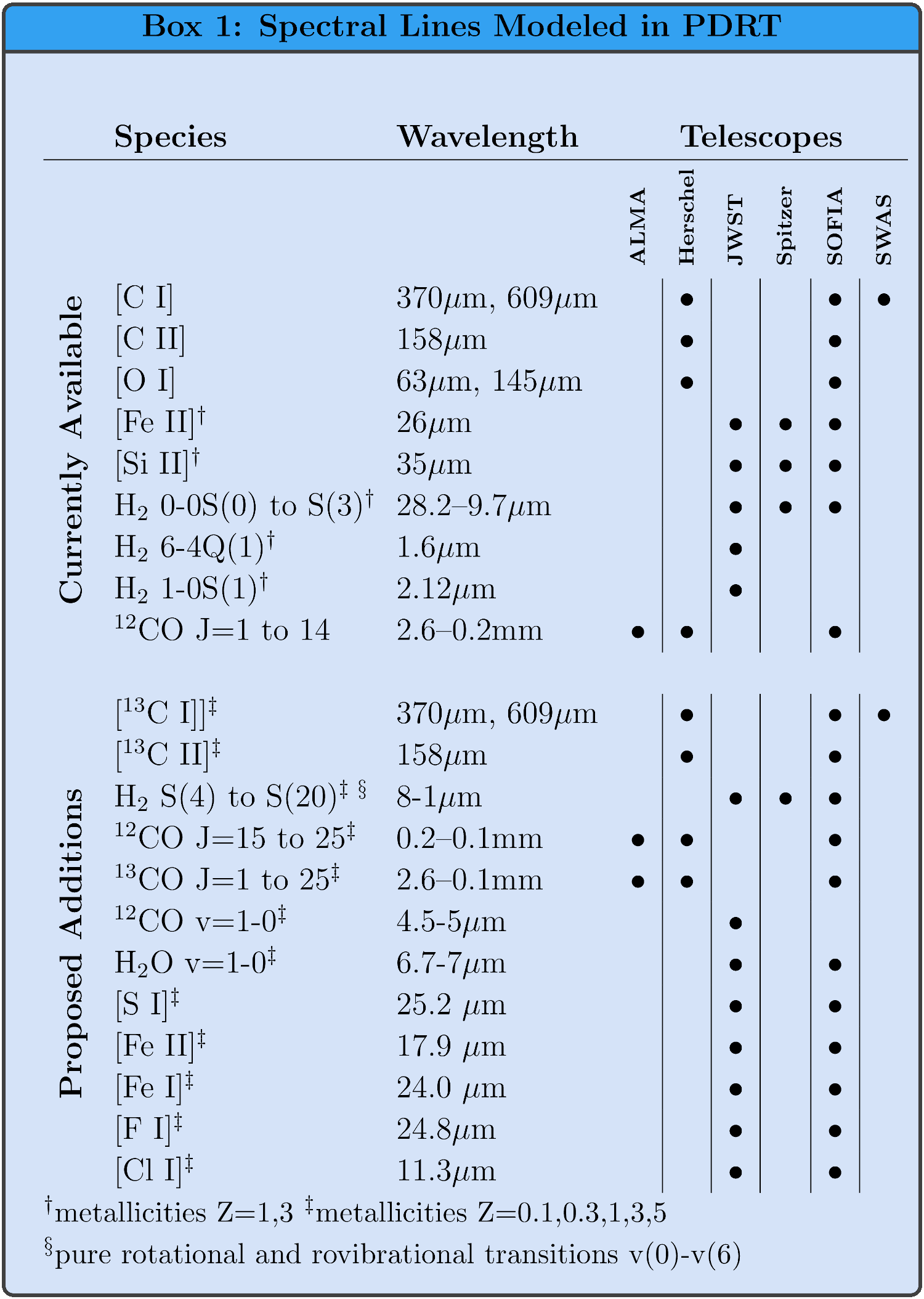WK Model Specifics
2020 Models
These model data start with the 2006 PDR model code and add improved physics and chemistry. Critical updates include those discussed in Neufeld & Wolfire 2016, plus photo rates from Heays et al. 2017, oxygen chemistry rates from Kovalenko et al. 2018 and Tran et al. 2018, and carbon chemistry rates from Dagdigian 2019. We have also implemented new collisional excitation rates for [O I] from Lique et al. 2018 (and Lique private communication) and have included 13C chemistry along with the emitted line intensities for [13C II] and 13CO. In Box 1, we show the currently available spectral lines and those we expect to deploy later in the project. In addition, we will compute ModelSets for a full range of metallicity \(Z\).
In pdrtpy, these are referred to as the wk2020 ModelSet.
2006 Models
These models are identical to those available in the "classic" web-based PDR Toolbox. They have metallicity \(Z=1\), and contain [C I], [C II], [O I], Fe, Si, H2 lines and the 12CO ladder up to \(J=14\rightarrow 13\). For some lines, \(Z=3\) is also available.
In pdrtpy, these are referred to as the wk2006 ModelSet.
WK Model Parameters
Our 2006 models use the standard parameters from Kaufman et al. 1999. Changes for the 2020 models are listed below. The formation rate of H2 goes as \(R_{form}~n_{HI}~n\). The PAH abundance \(X_{PAH}=n_{PAH}/n\).
| Parameter | Symbol | Value |
|---|---|---|
| Turbulent Doppler velocity | \(\delta v_D\) | 1.5 km s-1 |
| Carbon abundance | \(X_C\) | \(1.4\times10^{-4}\) |
| Oxygen abundance | \(X_O\) | \(3.0\times10^{-4}\) |
| Silicon abundance | \(X_{Si}\) | \(1.7\times10^{-6}\) |
| Sulfur abundance | \(X_{S}\) | \(2.8\times10^{-5}\) |
| Iron abundance | \(X_{Fe}\) | \(1.7\times10^{-7}\) |
| Magnesium abundance | \(X_{Mg}\) | \(1.1\times10^{-6}\) |
| Dust abundance relative to diffuse ISM | \(\delta_d\) | 1 |
| FUV dust absorption/visual extinction | \(\delta_{UV}\) | 1.8 |
| Dust visual extinction per H | \(\sigma_V\) | \(5\times10^{-22}\) cm-2 |
| Formation rate of H2 on dust | \(R_{form}\) | \(3\times10^{-17}\) s-1 |
| PAH abundance | \(X_{PAH}\) | \(5\times10^{-7}\) |
| Cloud H density | \(n\) | \(10^{1} - 10^{7}\) cm-3 |
| Incident UV flux | \(G_0\) | \(10^{-0.5} - 10^{6.5}\) Habing |
| Parameter | Symbol | Value |
|---|---|---|
| Carbon abundance | \(X_C\) | \(1.6\times10^{-4}\) |
| Oxygen abundance | \(X_O\) | \(3.2\times10^{-4}\) |
| Dust visual extinction per H | \(\sigma_V\) | \(5.26\times10^{-22}\) cm-2 |
| Formation rate of H2 on dust | \(R_{form}\) | \(6\times10^{-17}\) s-1 |
| PAH abundance | \(X_{PAH}\) | \(2\times10^{-7}\) |
